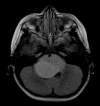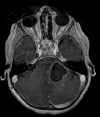Conventional and Advanced Imaging of Diffuse Intrinsic Pontine Glioma
- PMID: 27071471
- PMCID: PMC5659185
- DOI: 10.1177/0883073816634855
Conventional and Advanced Imaging of Diffuse Intrinsic Pontine Glioma
Abstract
Diffuse intrinsic pontine glioma is the most common brainstem tumor in pediatric patients. This tumor remains one of the most deadly pediatric brain tumors. The diagnosis primarily relies on clinical symptoms and imaging findings. Conventional MRI provides a noninvasive accurate method of diagnosis of these tumors. Advanced MRI techniques are becoming more widely used and studied as additional noninvasive methods to assist clinicians in initial diagnosis and staging, monitoring disease, as well as in surgical and radiation planning. This article will provide an overview of DIPG and describe the typical imaging findings with a focus on advanced imaging techniques.
Keywords: MRI; brainstem; diffuse intrinsic pontine glioma; pediatric; spectroscopy.
© The Author(s) 2016.
Figures






References
-
- Freeman CR, Farmer JP. Pediatric brain stem gliomas: a review. International journal of radiation oncology, biology, physics. 1998;40:265–71. - PubMed
-
- Hargrave D, Bartels U, Bouffet E. Diffuse brainstem glioma in children: critical review of clinical trials. The Lancet Oncology. 2006;7:241–8. - PubMed
-
- Guillamo JS, Doz F, Delattre JY. Brain stem gliomas. Current opinion in neurology. 2001;14:711–5. - PubMed
-
- Chintagumpala M, Gajjar A. Brain Tumors. Pediatric Clinics of North America. 2015;62:167–78. - PubMed
Publication types
MeSH terms
Grants and funding
LinkOut - more resources
Full Text Sources
Other Literature Sources

